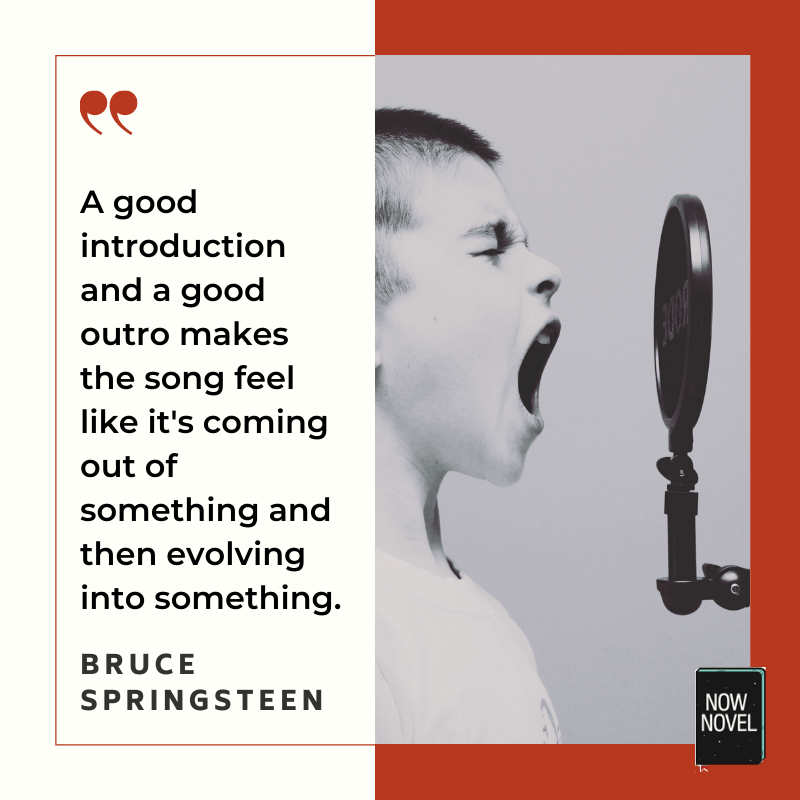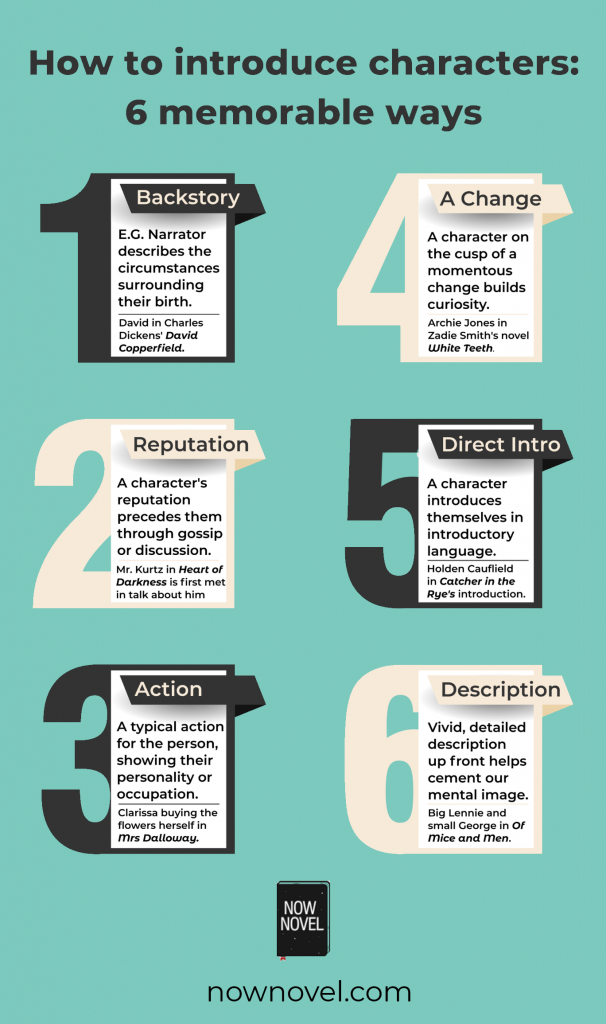Knowing how to introduce characters indeed that they control stick in readers' minds is a attainment. Here are six techniques to make memorable maiden impressions:
6 ways to introduce your characters:
- Use backstory to discover relevant character history
- Introduce a character through some other POV
- Indicate typical action
- Innovate a character on the cusp of change
- Relieve oneself characters introduce themselves directly
- Write a memorable, unique character description
Let's examine each of these character introduction ideas, with examples:
1: Use backstory to reveal germane role history
Telling a character's history gives readers a sense of their formative experiences. A person's erstwhile helps us sympathise their motivations, their psychological science.
If you choose this approach, there's a caution: deflect info mopes. Hold out backstory relevant to your character's floor arc and their present circumstances.
The opening of Charles Dickens' David Copperfield is a exemplar.
Example of backstory introduction:David Copperfield
In Dickens' autobiography-style story, the narrator introduces himself by telling the reader about the death of his founding father only six months earlier his birth:
I was born at Blunderstone, in Suffolk, or 'there by', as they enunciat in Scotland. I was a posthumous child. My father's eyes had squinting upon the light of this world six months, when mine opened thereon.
Charles John Huffam Dickens,David Copperfield, p. 4. Full text available hither.
This instauratio is effective connected cardinal levels:
- Due to the tragic and personal nature of St. David's backstory, we empathise with the character
- The entry is in question – David proceeds to tell of his mother's remarriage and how he is dispatched, at his maltreat-father's insistence, to in play with their housekeeper's family – a significant, key plat point
Dickens frankincense keeps David's backstory in hand to core plot developments, while also reeling the reader in with emotive inside information of personal history.

2: Introduce a character through another POV
As in life, fictional characters' reputations sometimes precede them.
This is specially true for villains. Showing early characters talk about a in question theatrical role before they get builds suspense.
Example of introducing characters via others' testimony:Heart of Darkness
In Joseph Conrad's novella about the brutalities of colonisation in Africa,Heart of Iniquity, Joseph Conrad introduces Kurtz (the violent head of an ivory trading-post) in stages.
First, the narrator Marlow hears from a colonial accountant that Kurtz is ill:
There were rumours that a very important station was in jeopardy, and its chief, Mr. Kurtz, was ill. [The accountant] hoped IT was not true. Mr. Kurtz was … I matte weary and irritable. Hang Kurtz, I thought. I off-and-on him aside saying I had heard of Mr. Kurtz on the coast. 'Ah! So they talk of him shoot down there,' he murmured to himself. Past he began again, assuring me Mr. Kurtz was the best agentive role He had, an exceptional human being, of the greatest importance to the Fellowship.
Joseph Conrad, Pump of Darkness, p. 30
Conrad builds rising to Marlow's low gear encounter with Kurtz. After this glowing description, Marlow meets a more than impartial Russian adventurer WHO has met Kurtz.
The Land paints a more sinister picture:
It was overcurious to project his mingled eagerness and reluctance to speak of Kurtz. The man filled his lifetime, occupied his thoughts, swayed his emotions. 'What can you expect?' he burst out; 'helium came to [the locals] with thunder and lightning, you know – and they had ne'er seen anything like it – and very atrocious.
Heart of Wickedness, p. 79.
The traveler tells Marlow more or less a time Kurtz threatened to fritter him if He didn't handwriting over a stash of ivory he had poached. Thus we see a darker image of Kurtz's character before seeing him in someone.
Like Joseph Conrad, you can introduce a character through others' perspectives and build suspense.

3: Show a typical fulfill
Introducing characters with actions is simple and effective. We may instruct a character's passions, hobbies, occupation, operating room another detail relevant to their floor.
Example of action-based introduction:Mrs. Dalloway
Take, for example, our 1st coming upon with Clarissa Dalloway, the title character of Virginia Woolf's Mrs. Dalloway:
Mrs.. Dalloway said she would buy the flowers herself.
For Lucy had her work cut out for her. The doors would be taken off their hinges; Rumpelmayer's workforce were future. And then, thought Clarissa Dalloway, what a morning – unfermented Eastern Samoa if issued to children connected a beach.VA Woolf, Mrs Dalloway, p. 1.
The sense of purpose, the fact Clarissa decides to buy in the flowers herself, shows her bring up-charge nature.
Woolf likewise shows Clarissa through the perspectives of passersby. Woolf thus combines a typical action for Clarissa (taking pondering walks) with others' viewpoints (another introduction technique).
E.g., Clarissa's neighbour's thoughts trespass happening the narration:
A charming woman, Scrope Purvis thought her (learned her as one does know people who dwell side by side door to one in City of Westminster); a touch of the bird near her, of the John Jay, blue-green, light, vivacious, though she was over fifty, and grownup very white since her malady.
Adeline Virginia Stephen Woolf,Mrs. Dalloway, pp. 1-2.
Virginia Woolf introduces a bit backstory (Scrope Purvis' mention of Clarissa's malady), incorporating yet another element of unveiling (backstory). Yet note how subtly a little bit of backstory is slipped in.
In the infinite of cardinal pages, Woolf hence effectively combines several of the shipway to write out character introductions mentioned in this send.
When you enter a character, show actions that:
- Instance a character's nature or temperament
- Bring them into contact with others WHO can flesh come out of the closet the reader's feeling further
In addition, let in clear physical description (by the second Page, we know Clarissa has a light, bird-the like tone and is over fifty and light-skinned).

Start profiling your story's plaster bandage
Make up detailed character profiles in well-off steps so you know who each character is before you introduce them.
START
4: Introduce a character on the cusp of change
Showing a person on the cusp of alteration is one of the suspense-building options among how to introduce characters. .
Showing a character in a quandary, well-nig to make a life-changing determination, propels your story forwards.
Take Zadie Smith's innovation of the character Archie Jones in her novel White Teeth.
Example of cusp-of-change introduction:Whitened Dentition
At the start of Zadie Kathryn Elizabeth Smith's entry novel, Archie Mary Harris Jone, recently unmarried, attempts to kill himself in his car:
Early in the morning, late in the C, Criklewood Broadway. At 06.27 hours along 1 Jannuary 1975, Alfred Archibald Jones was dressed in cord and sat in a fume-occupied Cavalier Musketeer Estate face down connected the steerage wheel around, hoping the judgement would not cost too heavy upon him.
Zadie Smith, White Teeth, p. 3.
This strong instauratio conveys Archie's psychological state, his despair and decision to end his life.
Smith introduces dark humour when Mo, a local halal butcher, interrupts Archie because he's parked in Mo's delivery loading bay:
'Show Me State advanced upon Archie's car, pulled out the towels that were sealing the gap in the driver's window, and pushed it down five inches with brute, bullish force.
"Execute you hear that, mister? We're not licensed for suicides about here. This place is halal. Kosher, understand?'Smith, Patrick White Teeth, p. 7.
Through this fundamental interaction Smith shows a melting pot of characters in her London setting. We are intrigued, curious why Archie wants to end his life.

Leap out to Top
5: Make characters introduce themselves directly
This type of character founding is particularly familiar in first soul novels where the admirer is also the narrator.
The teller Taylor Greer in Barbara Kingsolver's novel The Edible bean Trees is one example.
Example of a character introducing themselves:The Bean plant Trees
The Bean Trees opens thus:
I have been afraid of putting air in a tire ever since I saw a tractor tire blow up and throw Newt Hardbine's father o'er the top of the Standard Oil sign. I'm non mendacious. Helium got stuck up at that place. Some nineteen people congregated during the time it took for Norman Strick to walk adequate to the Courthouse and blow the whistle for the volunteer fire department.
Barbara Kingsolver, The Bean Trees, p. 1.
Kingsolver starts with a strong emotion: Fear.
The character introduction conveys President Taylor's rural background by describing an incident involving a tractor.
Over the course of the novel, we con more about Taylor's fears (for instance, her fear of falling pregnant like umteen of the girls support home in agrestic Kentucky).
Taylor has to confront her fears when she finds and adopts an abandoned babe girl. Fear (and overcoming it) is thus central to the novel.
So it's fitting that at the start of the novel, Elizabeth Taylor recounts a fear-inducing event back menage.
When you introduce characters directly, as best-person narrators, make them:
- Reveal their personalities – in Deems Taylor's case, she is discovered as fearful, a fear she is forced to confront as the story unfolds
- Credible: Taylor's manner of speaking is natural. The way she adds 'I'm not lying' to her tall tale adds personality and an element of self-awareness
6: Write a memorable, unique personal description
When introducing characters, give readers the detail they need to picture them.
In Trick Steinbeck's Of Mice and Workforce, we develop a exact image of two co-travelers, the central characters.
Example of pure character introduction via description:Of Mice and Men
Steinbeck introduces the simple, large Lennie and the small, shrewd George with this verbal description:
Both were dressed in dungaree trousers and in denim coats with brass buttons. Some wore black, shapeless hats and some carried fine blanket rolls slung over their shoulders. The first adult male was small and promptly, dark of face, with restless eyes and sharp, strong features. Every part of him was defined: small, beefed-up manpower, slender arms, a thin and bony nose. Behind him walked his opposite, a vast man, shapeless of face, with large, pallid eyes, with wide, sloping shoulders; and he walked heavily, dragging his feet a little, the path a pay drags his paws.'
King John John Ernst Steinbeck,Of Mice and Manpower, p. 8.
Steinbeck's detailed verbal description begins with George and Lennie's clothing.
From here, he describes different features, St. George's fineness and chiseled face and Lennie's 'shapelessness'.
He also describes both with posture and movement. Lennie drags his feet 'the way a turn out drags his paws'.
Shortly later on this verbal description, when they get hold of a clearing, Lennie 'flings' himself dispirited, spell George steps 'nervously'.
The way some characters move matches their temperaments and the preceding physical description.
When introducing a character visually, admit:
- Identifying dress
- Physical features (their facial features, body type, etc.)
- Some feature movement (e.g. Lennie's suffer-like pace)
Start profiling detailed characters the simple way in Now Novel's outlining dashboard.
the part of the story that introduces characters is
Source: https://www.nownovel.com/blog/how-to-introduce-characters/